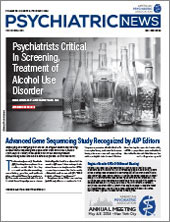Decades of neuroscientific advances have led to a host of safer and more tolerable treatments in our psychiatric armamentarium. However, despite a major commitment to the evidence-based practice of pharmacotherapy, treatment refractoriness remains a significant problem for those with psychiatric illness, and, for many of the most prevalent psychiatric conditions, there is little evidence that outcomes are substantially better than they were a half-century ago. There are many reasons for this, including the true complexity of many psychiatric illnesses and the current limitations of our treatments. One correctable reason, however, may have to do with a narrow or reductionist understanding of evidence-based psychiatric practice. Typically, when we reference evidence-based practice, we are referring to the matching of DSM-defined disorders with biomedical treatments shown in placebo-controlled studies to be effective for those disorders.
There are, however, other evidence bases, too often neglected, that provide guidance not about
what to prescribe, but rather,
how to prescribe to optimize outcomes (see the paper by David Flynn, M.D., and me noted at the end of this article). The evidence base in this regard suggests that the psychosocial dimensions of pharmacotherapy contribute substantially to pharmacotherapy outcomes. Indeed, for some of the most common psychiatric conditions (for example, depression), the evidence suggests that psychosocial factors in prescribing (the person of the patient, the person of the doctor, placebo effects, and the quality of the doctor-patient alliance) contribute more to outcomes than the putative active ingredient of those medications.
For example, a secondary analysis of the data from the Treatment of Depression Collaborative Research Project (TDCRP), which was, before STAR*D, the largest, NIMH-funded, multicenter, placebo-controlled randomized trial that had been conducted, looked at outcomes through the lens of the prescriber. The
analysis, published in the June 2006
Journal of Affective Disorders, indicated that, if TDCRP prescribers got a good outcome with one patient, they tended to get superior outcomes with all their patients, and prescribers who got poorer outcomes with one patient tended to get poorer outcomes overall. Using linear hierarchical modeling, the researchers were able to stratify the prescribers into highly effective, moderately effective, and relatively ineffective prescribers. Effects were additive, so that patients had the best outcomes when they had an effective prescriber and got the active antidepressant, and patients had the worst outcomes when they had a relatively ineffective prescriber and were administered placebo treatment. Most striking, however, was the finding that the top third of prescribers achieved better antidepressant results with placebo than the bottom third achieved with active drug.
This should perhaps not be so surprising when we consider that effect sizes of antidepressants tend to fall around 0.35, while effect sizes of placebo in antidepressant trials are around 1.05. The placebo effect is a complex phenomenon that is shaped by the set and setting of treatment, including the “how” of medication administration and the quality of the doctor-patient relationship.
The therapeutic relationship is also a powerful tool for enhancing outcomes in pharmacotherapy.
Another secondary analysis of the TDCRP data was published by Janice L. Krupnick and colleagues in the April 2006 issue of Focus. The researchers explored how the therapeutic alliance contributed to outcomes. While they expected to find the alliance to be central to psychotherapeutic outcomes but only marginally impactful in pharmacotherapy, instead they found that the alliance contributed equally to outcomes in both treatment conditions. Indeed, their analysis found that patients with a positive therapeutic alliance with their prescriber had greater reductions in depression with placebo than patients with a poor alliance achieved with active antidepressant. Further, there is a substantial evidence base that paints a picture of the skills and practices needed to establish a sound pharmacotherapeutic alliance. (See my book
Psychodynamic Psychopharmacology: Caring for the Treatment-Resistant Patient from APA Publishing.)
Even with the effective use of alliance-promoting behaviors, patients may carry unarticulated concerns into treatment (for example, the residue of traumatic relations with caregivers) that adversely affect treatment outcomes. Multiple psychological variables, such as the patient’s expectations, contribute to the placebo response, potentiating treatment response when expectations are positive or undermining it when the patient is ambivalent about treatment and/or expectations are negative. Occasionally, such psychological sources of treatment resistance may be addressed by simple psychoeducation. However, frequently, these resistances are connected to deeper and often unconscious sources. In such cases, it is the psychiatrist’s capacity to empathically appreciate those factors and intervene at the level of meaning that may be the factor that turns treatment-resistance into treatment response.
Studies such as those referred to (and there are many more) suggest that, for the benefit of our patients, psychiatric prescribers should be thoroughly versed in the psychosocial evidence bases that guide us in knowing how effectively to prescribe, and not just the biomedical evidence bases that tell us what to prescribe. For a truly evidence-based practice, psychiatrists should develop skills for engaging patients in ways that foster the alliance, engage resistances to the healthy use of medications, and optimize psychological factors (for example, placebo effects) that have been shown to promote good pharmacotherapy outcomes, amplifying the benefits of the medication itself. ■

